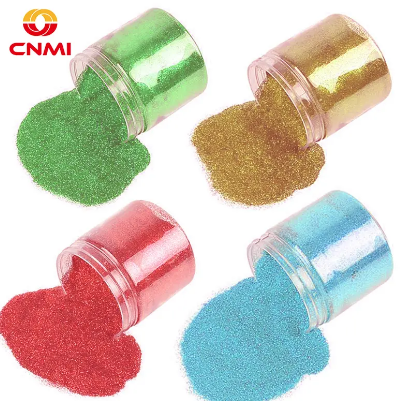English








In the realm of art and design, glitter pigment has emerged as a transformative element, offering a spectrum of possibilities for creative expression. This article delves into the intricacies of glitter pigment, exploring its composition, applications, and the science behind its shimmering allure. For those interested in the broader category of pigments, our detailed guide on glitter color pigments provides further insights.
Glitter pigment is a type of particulate material that reflects light, creating a sparkling effect. It is composed of small, flat particles that are typically made from materials such as aluminum, titanium dioxide, or other reflective substances. These particles are coated with various colors to produce the desired hue and effect. The size and shape of the particles can vary, influencing the intensity and type of sparkle produced.
There are several types of glitter pigments, each with unique characteristics. Cosmetic-grade glitter is designed for use in makeup and is safe for skin contact. Industrial-grade glitter is used in applications such as automotive paints and coatings. The size of the glitter particles can range from fine to chunky, with finer particles offering a subtle shimmer and larger particles providing a more pronounced sparkle.

Glitter pigment is used across various industries, from cosmetics to automotive manufacturing. In cosmetics, it is a staple in products like eyeshadows, nail polishes, and lip glosses, where it adds a dazzling effect. In the automotive industry, glitter pigments are incorporated into paints to give vehicles a distinctive, eye-catching finish. Additionally, glitter pigments are used in arts and crafts, providing artists with a medium to enhance their work with a touch of sparkle.
One of the most popular uses of glitter pigment is in conjunction with epoxy resin. When mixed with epoxy resin, glitter pigments create stunning effects in resin art, jewelry, and furniture. The resin encapsulates the glitter, enhancing its reflective properties and protecting it from environmental damage. This combination is particularly favored for creating river tables and decorative pieces.
The sparkle of glitter pigment is a result of its ability to reflect and refract light. The flat surfaces of the glitter particles act as tiny mirrors, reflecting light in multiple directions. This reflection is enhanced by the refractive index of the materials used, which bends the light as it passes through the particle. The color of the glitter is determined by the coating applied to the particles, which can be metallic, holographic, or iridescent, each offering a different visual effect.
Several factors can influence the performance of glitter pigment, including particle size, shape, and the medium in which it is used. Larger particles tend to produce a more dramatic sparkle, while smaller particles offer a subtle sheen. The shape of the particles, whether hexagonal, square, or irregular, also affects the way light is reflected. The medium, such as a clear or colored base, can enhance or mute the glitter's effect.
While glitter pigment offers aesthetic appeal, it is important to consider its environmental impact. Traditional glitter is made from plastic, which can contribute to microplastic pollution. As a result, there is a growing trend towards biodegradable glitter, made from plant-based materials that break down naturally. Safety is also a concern, particularly in cosmetic applications, where it is crucial to use glitter that is safe for skin contact and free from harmful chemicals.
Recent innovations in glitter pigment technology have focused on creating eco-friendly and safe alternatives. Biodegradable glitter, for example, is made from cellulose derived from eucalyptus trees. This type of glitter is not only environmentally friendly but also offers the same level of sparkle and color vibrancy as traditional glitter. Additionally, advances in manufacturing processes have led to the development of glitter pigments that are more resistant to fading and degradation.
Glitter pigment continues to captivate artists, designers, and manufacturers with its dazzling effects and versatility. As the industry evolves, the focus on sustainability and safety will likely drive further innovations in glitter pigment technology. For those looking to explore the world of glitter pigments, understanding their composition, applications, and environmental impact is essential. Our comprehensive guide on glitter color pigments offers a deeper dive into this fascinating subject.
1. What is glitter pigment made of?
Glitter pigment is typically made from materials like aluminum or titanium dioxide, coated with various colors to achieve the desired effect.
2. How is glitter pigment used in epoxy resin?
When mixed with epoxy resin, glitter pigment creates a reflective and durable finish, ideal for art, jewelry, and furniture projects.
3. Are there eco-friendly glitter pigments available?
Yes, biodegradable glitter made from plant-based materials is available, offering an environmentally friendly alternative to traditional plastic glitter.
4. What factors affect the sparkle of glitter pigment?
Particle size, shape, and the medium used can all influence the intensity and quality of the sparkle produced by glitter pigment.
5. Is glitter pigment safe for use in cosmetics?
Cosmetic-grade glitter is designed to be safe for skin contact, but it is important to ensure it is free from harmful chemicals.
6. What are the latest innovations in glitter pigment technology?
Recent innovations include the development of biodegradable glitter and advancements in manufacturing processes to enhance durability and color vibrancy.
7. How does the size of glitter particles affect their performance?
Larger particles tend to create a more dramatic sparkle, while smaller particles offer a more subtle sheen.